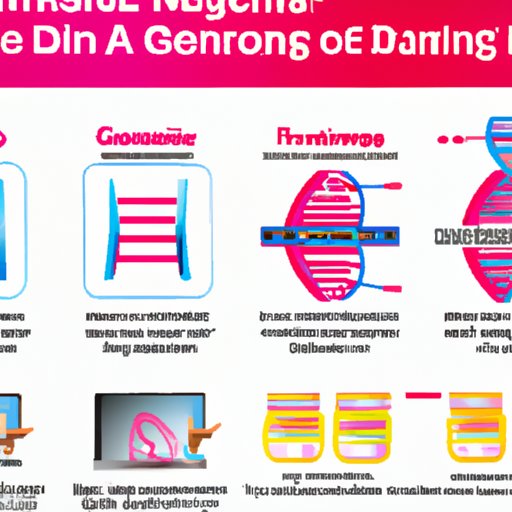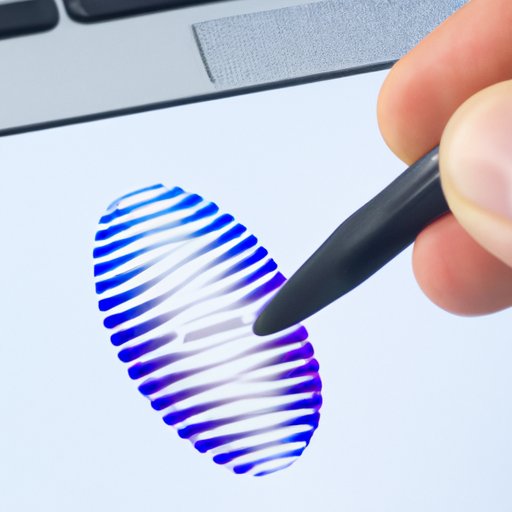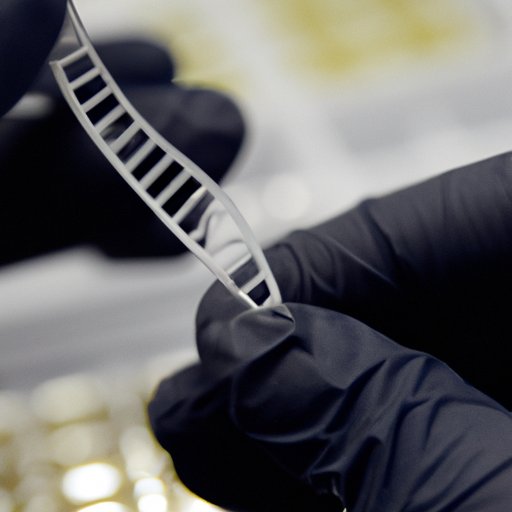Introduction
DNA fingerprinting is a powerful tool used by scientists to identify individuals based on their unique genetic signature. It is used in a variety of fields including criminal justice, forensics, paternity testing, and medical research. This article will explore the science behind DNA fingerprinting and examine the comprehensive steps involved in the process. It will also look at the different types of DNA fingerprinting and their uses as well as the advantages and disadvantages of the technique.
Exploring the Science Behind DNA Fingerprinting
Before we dive into the specifics of how DNA fingerprinting works it is important to understand what DNA is and how it can be used to identify individuals. DNA stands for deoxyribonucleic acid and is the hereditary material found in the cells of all living organisms. It contains the instructions for producing proteins, which are responsible for the growth and development of an organism. Every individual has their own unique set of DNA and this can be used to identify them.
DNA fingerprinting is a process that involves taking a sample of an individual’s DNA and then analyzing it in order to determine their unique genetic profile. The process is fairly complex but can be broken down into several steps. First, a sample of DNA must be collected from the individual. This can be done using a variety of methods such as swabbing the inside of the cheek or collecting a sample of blood or other bodily fluid. Once the sample has been collected, it must then be extracted from the cells and purified.
Once the DNA has been extracted it is then subjected to a process called polymerase chain reaction (PCR). This process involves using enzymes to replicate the DNA many times over so that there is enough material to analyze. After the DNA has been replicated it is then sequenced, which involves breaking it down into its component parts. Finally, the sequence is compared to a database of known sequences in order to identify the individual’s unique genetic profile.
An Overview of the Steps Involved in DNA Fingerprinting
The following is an overview of the steps involved in DNA fingerprinting:
- Sample collection: A sample of DNA must be collected from the individual. This can be done using a variety of methods such as swabbing the inside of the cheek or collecting a sample of blood or other bodily fluid.
- DNA extraction: Once the sample has been collected, it must then be extracted from the cells and purified.
- Polymerase Chain Reaction (PCR): Once the DNA has been extracted it is then subjected to a process called polymerase chain reaction (PCR). This process involves using enzymes to replicate the DNA many times over so that there is enough material to analyze.
- DNA sequencing: After the DNA has been replicated it is then sequenced, which involves breaking it down into its component parts.
- Comparison and analysis: The sequence is then compared to a database of known sequences in order to identify the individual’s unique genetic profile.

A Comprehensive Guide to How DNA Fingerprinting Works
Now that we have explored the basics of DNA fingerprinting, let’s take a look at the step-by-step process in more detail.
Step 1: Sample collection – A sample of DNA must be collected from the individual. This can be done using a variety of methods such as swabbing the inside of the cheek or collecting a sample of blood or other bodily fluid.
Step 2: DNA extraction – Once the sample has been collected, it must then be extracted from the cells and purified.
Step 3: Polymerase Chain Reaction (PCR) – Once the DNA has been extracted it is then subjected to a process called polymerase chain reaction (PCR). This process involves using enzymes to replicate the DNA many times over so that there is enough material to analyze.
Step 4: DNA sequencing – After the DNA has been replicated it is then sequenced, which involves breaking it down into its component parts.
Step 5: Comparison and analysis – The sequence is then compared to a database of known sequences in order to identify the individual’s unique genetic profile.

The Different Types of DNA Fingerprinting and Their Uses
There are several different types of DNA fingerprinting techniques and each one has its own unique set of advantages and disadvantages. Here is an overview of the most common types of DNA fingerprinting and their uses.
Short Tandem Repeat (STR) testing: This type of DNA fingerprinting is used to compare multiple regions of DNA in order to identify a person’s unique genetic profile. It is commonly used in criminal investigations and paternity testing.
Single Nucleotide Polymorphism (SNP) testing: This type of DNA fingerprinting is used to identify variations between individuals at the single nucleotide level. It is commonly used in medical research and drug development.
Mitochondrial DNA testing: This type of DNA fingerprinting is used to trace maternal lineages and is often used in forensic science and archeology.

Examining the Advantages and Disadvantages of DNA Fingerprinting
As with any scientific process, there are both advantages and disadvantages to DNA fingerprinting. Here are some of the key advantages and disadvantages associated with the technique.
Advantages: DNA fingerprinting is highly accurate and reliable, making it an ideal tool for identifying individuals. It is also non-invasive and cost-effective, making it accessible to a wide range of people. Finally, it is a quick process, allowing for results to be obtained within a short period of time.
Disadvantages: One of the main disadvantages of DNA fingerprinting is that it requires a large amount of data to be processed, which can be both time consuming and expensive. Additionally, the technique relies heavily on the accuracy of the database being used, so any errors or inaccuracies in the data could potentially lead to false results.
Conclusion
This article has explored the science behind DNA fingerprinting and examined the comprehensive steps involved in the process. It has also looked at the different types of DNA fingerprinting and their uses as well as the advantages and disadvantages of the technique. DNA fingerprinting is a powerful tool that can be used to accurately identify individuals and is used in a variety of fields including criminal justice, forensics, paternity testing, and medical research. While the process can be complex, it is essential to understanding how DNA fingerprinting works.
(Note: Is this article not meeting your expectations? Do you have knowledge or insights to share? Unlock new opportunities and expand your reach by joining our authors team. Click Registration to join us and share your expertise with our readers.)
